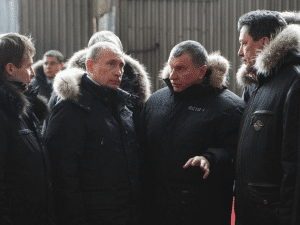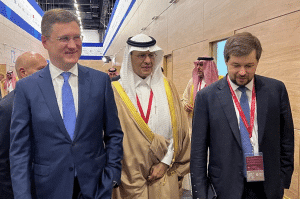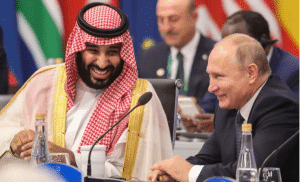PNN – Currently, Russia and Saudi Arabia are mutually beneficial at best, but this cooperation is shaped around a narrow agenda of oil market stability, which may be a shaky foundation for long-term bilateral relations.
With the beginning of the conflicts between Russia and Ukraine in 2022 and the imposition of the most severe sanctions by the European Union and the United States on the Russian economy, especially the energy sector, in the hope of causing economic shocks to this country to end the war in Ukraine, every day we witness the deepening of the gap between Russia and the countries. In parallel with this, Moscow tried to expand and strengthen its relations with other countries, including the countries of the south and especially the countries of the Middle East, in order to compensate for this gap.
While many researchers and international media are trying to dissect Russia’s relations with the West, another narrative is revealed. A narrative related to the change in the Kremlin’s foreign policy approach and Russia’s evolving alliances with the Arab world. After the collapse of the Soviet Union, Russia has largely inherited the foreign policy of this empire towards the Middle East. In analyzing the growing relations and contemporary cooperation between Russia and the Arabs, understanding the historical roots of this interaction and its consequences for global geopolitics seems essential.
Modern Russia and the Middle East
After World War II, the Soviet Union established relations with “progressive” and socialist regimes in Algeria, Egypt, Iraq, Libya, South Yemen, and Syria, and at the same time with “reactionary” Persian Gulf monarchies with close ties to Western structures, especially The United States was at odds.
The Soviet invasion of Afghanistan in 1979 reduced the image of the Soviet Union in the eyes of the Arabs, especially in countries such as Saudi Arabia, which supported anti-Soviet guerrilla fighters during the Soviet–Afghan War. But at the same time, the Soviet Union was linked in complex ways to the oil-producing countries of the Arab world.
The relations between the Soviet Union and the Arab countries alternated between cooperation and competition, while these relations were significantly influenced by oil production strategies. Since Saudi Arabia played a leading role in the Organization of the Petroleum Exporting Countries (OPEC) and was an important oil producer, Russian-Saudi relations have mostly witnessed periods of friendship and distance.
After the dissolution of the Soviet Union in 1991, modern Russia inherited its complicated relations with OPEC member countries, including Saudi Arabia, from the previous government, but in the early years, Moscow lacked a clear strategy for interacting with these countries. In addition, Russian oil production was in free fall as a result of economic crises, organizational upheavals, and years of underinvestment and overproduction in the late Soviet era.
Therefore, the Saudi side was less interested in attracting Russia’s cooperation in OPEC. The beginning of the first Chechen war in 1994 also contributed to mutual caution in Moscow-Riyadh relations. The Russians suspected the Saudis of supporting Chechen rebels and fomenting separatism in the Muslim-majority regions of Russia.
In fact, some Saudis were fighting alongside the rebels, and Saudi-based charities were raising funds (both charitable and military) for the Chechen fighters’ causes. At the same time, the story of the killing of Russian soldiers in the so-called operation to clean up Chechen villages created an uproar in the Muslim world and completely distorted the image of modern Russia among these countries.

In the early 2010s, Russia and Saudi Arabia realized each other’s important role in the global oil market. Despite the tensions, especially Russia’s direct support to the government of Syrian President Bashar al-Assad in the country’s conflicts, Saudi Arabia welcomed Russia’s membership in OPEC. But Russia, which saw itself as a rising power as a member of the Group of Eight, the World Trade Organization, and possibly the Organization for Economic Development, was reluctant to cede influence or align its policies with those of other states. Moscow preferred to maintain a large degree of independence while benefiting from market conditions shaped by OPEC. But very soon this situation changed due to increasing geopolitical tensions.
OPEC Plus, a new era of Saudi-Russian relations
The period between 2014 and 2020 witnessed significant changes in the global dynamics of oil markets with increased cooperation between OPEC and non-OPEC members, especially between Saudi Arabia and Russia. The most important reason for these changes was the evolving political and economic strategic interests in the international system.
The annexation of Crimea to Russia in the spring of 2014, followed by the conflict in Donbass, led to Russia’s expulsion from the G8 group and flared up the Kremlin’s long-standing political conflicts with Western countries. As a result, Moscow was left out by European countries and America in some areas, and because of this, it had to look for new alliances and partners.
The market reacted to this increase in supply with a sharp drop in oil prices, from an average of $108.93 per barrel Brent in the first half of 2014 to $55.27 per barrel by the end of the year. Unlike in 1998, 2001, or 2008, this drop was not caused by a demand shock due to the economic crisis, but rather by a major advance in oil production and extraction technology. Therefore, we cannot expect prices to increase along with the improvement of the global economy. Moreover, it became clear that OPEC, with its market share declining, no longer has the capacity to stabilize the market on its own.

In January 2015, Salman bin Abdulaziz became the new king of Saudi Arabia after the death of his father, King Abdullah. This, in turn, was the beginning of the appearance of “Prince Muhammad Bin Salman”.
In March 2015, just one month after the appointment of Mohammed bin Salman as the Minister of Defense, Saudi Arabia began military operations against the Houthis. Understanding with Russia about Yemen was important for the development of relations, and in June 2015, the prince visited the St. Petersburg International Economic Forum, where he met with Russian President Vladimir Putin and then with the country’s Energy Minister Alexander Novak.
This shift in political calculations is likely to hasten talks between the parties on a potential comprehensive deal between Russia and OPEC. But the signing of the agreement took a year and a half until the change of the Saudi energy minister.

From 2016 to late 2019, the OPEC+ agreement worked well and oil prices stabilized and increased. After the collapse of oil prices in 2014, global investment in the oil industry decreased by 45%. Russian-Saudi agreements in the energy sector were facilitated by strong personal ties between the two energy ministers and their aides. Both sides tried to establish wider cooperation between Saudi Arabia’s Aramco and Russian oil companies, but with little success. Because there was no chance for Russian oil companies to participate in Saudi Arabian oil projects, and Saudi Aramco did not need any projects in Russia.
Budding relationship in the test plant
Saudi-Russian relations were tested during the oil price war in 2020. From 2016 to 2019, OPEC+ focused on the stability of the oil market. Their strategy aimed to manage market expectations, eliminate excess supply, and compensate for shortages caused by global events, without raising prices above sustainable levels.
In the fall of 2019, the Saudis in OPEC+ began advocating a return to old policies that meant giving up market share in the hope that higher prices would compensate for lower production volumes. This change in policy was the result of a change in leadership.
In September 2019, Prince Abdulaziz bin Salman replaced Saudi Arabia’s veteran energy minister, Khaled al-Falih. He was the half-brother of Prince Mohammed bin Salman and the first person from the royal family to achieve this title and take the helm of the Saudi Ministry of Energy.
In early March 2020, this dispute between OPEC+ members, especially Russia and Saudi Arabia, turned into a conflict. Abdulaziz had to prove his efficiency in the new role and establish his authority. He argued that the Covid-19 pandemic that has spread in China could reduce China’s demand for oil. But the Russians argued that it was better to wait for a clear picture and not cut production based on conflicting forecasts rather than definitive data.
Anticipating this outcome, Saudi Arabia stockpiled large reserves of oil ahead of a potentially contentious meeting with Russia and leased additional tankers so they could immediately put more oil on the market. The next day, Saudi Arabia announced huge discounts to its April 2020 price announcements, suggesting it could produce up to 12.5 million bpd, or 3 million bpd more than it produced in February.
Other oil countries followed this method and started producing at their highest capacity. This increase in production at the same time as the sharp decrease in global oil demand due to the widespread quarantines of Covid-19 caused a significant mismatch between supply and demand in the global oil market.
Replacing energy sources is a common threat
Russia and Saudi Arabia have a similar approach to energy transition from fossil fuels to clean energy.
This belief was especially evident during the discussions leading up to the 2021 United Nations Climate Change Conference (COP 26) in Glasgow, Scotland. Where Russia and Saudi Arabia expressed their views that the energy transition will happen more slowly than many predict.
Ukraine’s post-war relations
When Russia invaded Ukraine in 2022, GCC countries resisted U.S. pressure to condemn the attack. While they finally voted for the UN resolution condemning the war.
But this move was largely symbolic and did not mean a fundamental commitment to Western views. For the Persian Gulf countries, the conflict between Russia and Ukraine is considered a distant issue, and it seems that they prefer to remain neutral in this type of challenge rather than take a particular side.
But their stance on the challenge does not mean they are not interested in the international implications of the Ukraine war. The conflict has sparked a trade war in the energy sector as the West must look for other sources to replace Russian oil.

In recent years, the United Arab Emirates has become the home of many of Russia’s wealthy, serving as a safe haven for their yachts and luxury wealth. In particular, Dubai has become a major transportation hub for Russian travelers who intend to travel to European countries. Despite these developments, recent pressure from the United States has prompted the United Arab Emirates to introduce stricter regulations on the flow of money and goods related to Russia. Nevertheless, the last two years have been very profitable for the country.
A game between East and West
In August 2023, Saudi Arabia and the United Arab Emirates were among the 6 countries that received an invitation to join the intergovernmental organization BRICS, and on January 1, 2024, their membership was finalized by Vladimir Putin. An organization that started as a new spectrum of emerging markets has now become a potential heavyweight against the G7.
Perhaps, one of the purposes that Moscow seeks for the development and expansion of BRICS in the current conditions of the international system is to show the absence of international isolation and create a sphere of legitimacy for itself. While the Gulf States may not necessarily accept these concepts, they are looking for opportunities to protect their role as junior partners of the United States.

Meanwhile, despite China leading the way in wind, solar and electric vehicles, Beijing continues to grow its energy imports. Perhaps, considering such changes, it can be argued that China is becoming a more important partner for the Persian Gulf countries than the United States. Saudi Arabia links its 2030 vision with China’s Belt and Road Initiative (BRI). Saudi Arabia has recently become the largest recipient of BRI investment in the region.
At the same time, Russia has become increasingly dependent on China as a major buyer of its natural resources and a major supplier of Russian imports.
Now, Moscow and Riyadh enjoy mutually beneficial cooperation at best, but this cooperation is shaped around a narrow agenda: oil market stability, which may be a shaky foundation for long-term bilateral relations.

